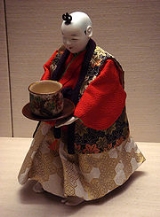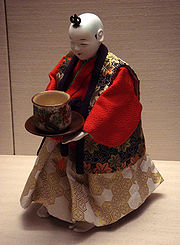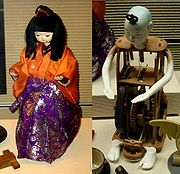
Karakuri
Encyclopedia


Puppet
A puppet is an inanimate object or representational figure animated or manipulated by an entertainer, who is called a puppeteer. It is used in puppetry, a play or a presentation that is a very ancient form of theatre....
s or automata
Automata
Automata is the plural form of automaton, a self-operating machine. It may also refer to:* "Automata", a short story by E. T. A. Hoffmann* "Automata", a hardboiled science fiction crime series by Penny Arcade...
from Japan
Japan
Japan is an island nation in East Asia. Located in the Pacific Ocean, it lies to the east of the Sea of Japan, China, North Korea, South Korea and Russia, stretching from the Sea of Okhotsk in the north to the East China Sea and Taiwan in the south...
from the 17th century to 19th century. The word karakuri means "mechanisms" or "trick". In Japanese ningyō
Ningyo
is a fish-like creature from Japanese folklore. Anciently, it was described with a mouth like a monkey's, small teeth like a fish's, shining golden scales, and a quiet voice like a skylark or a flute. Its flesh is pleasant-tasting, and anyone who eats it will attain remarkable longevity...
is written as two separate characters, meaning person and shape. It may be translated as puppet
Puppet
A puppet is an inanimate object or representational figure animated or manipulated by an entertainer, who is called a puppeteer. It is used in puppetry, a play or a presentation that is a very ancient form of theatre....
, but also by doll
Doll
A doll is a model of a human being, often used as a toy for children. Dolls have traditionally been used in magic and religious rituals throughout the world, and traditional dolls made of materials like clay and wood are found in the Americas, Asia, Africa and Europe. The earliest documented dolls...
or effigy
Effigy
An effigy is a representation of a person, especially in the form of sculpture or some other three-dimensional form.The term is usually associated with full-length figures of a deceased person depicted in stone or wood on church monuments. These most often lie supine with hands together in prayer,...
. The dolls' gestures provided a form of entertainment.
Three main types of karakuri exist. were used in theatre
Theatre
Theatre is a collaborative form of fine art that uses live performers to present the experience of a real or imagined event before a live audience in a specific place. The performers may communicate this experience to the audience through combinations of gesture, speech, song, music or dance...
. were small and used in homes. were used in religious festivals, where the puppets were used to perform reenactments of traditional myth
Mythology
The term mythology can refer either to the study of myths, or to a body or collection of myths. As examples, comparative mythology is the study of connections between myths from different cultures, whereas Greek mythology is the body of myths from ancient Greece...
s and legend
Legend
A legend is a narrative of human actions that are perceived both by teller and listeners to take place within human history and to possess certain qualities that give the tale verisimilitude...
s.
They influenced the Noh
Noh
, or - derived from the Sino-Japanese word for "skill" or "talent" - is a major form of classical Japanese musical drama that has been performed since the 14th century. Many characters are masked, with men playing male and female roles. Traditionally, a Noh "performance day" lasts all day and...
, Kabuki
Kabuki
is classical Japanese dance-drama. Kabuki theatre is known for the stylization of its drama and for the elaborate make-up worn by some of its performers.The individual kanji characters, from left to right, mean sing , dance , and skill...
and Bunraku
Bunraku
, also known as Ningyō jōruri , is a form of traditional Japanese puppet theater, founded in Osaka in 1684.Three kinds of performers take part in a bunraku performance:* Ningyōtsukai or Ningyōzukai—puppeteers* Tayū—the chanters* Shamisen players...
theatre.
Zashiki karakuri
The most common example today of a zashiki karakuri mechanism is shown at the right. It is a tea-serving robot, which starts moving forward when a cup of tea is placed on the plate in its hands. It was used in a situation when a host wanted to treat a guest in a recreational way. It moves in a straight line for a set distance, moving its feet as if walking, and then bows its head. This signals that the tea is for drinking, and the doll stops when the cup is removed. When it is replaced, the robot raises its head, turns around and returns to where it came from. It is typically powered by a wound spring made of whalebone, and the actions are controlled by a set of cams and levers.External links
- Karakuri.info English information site

